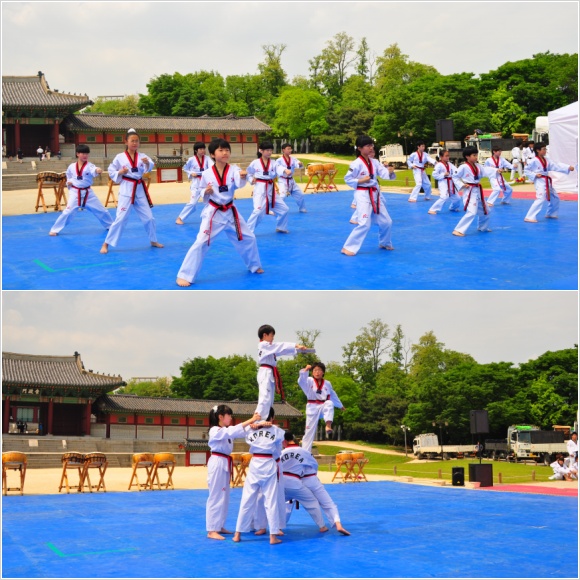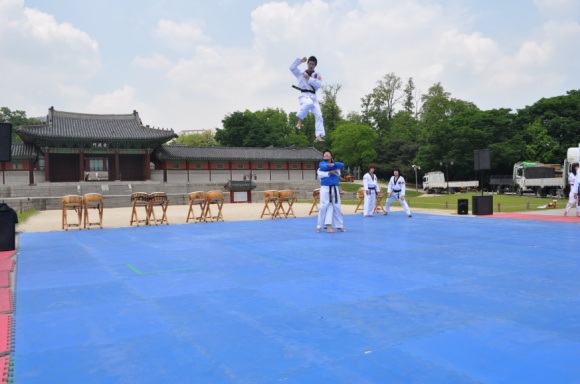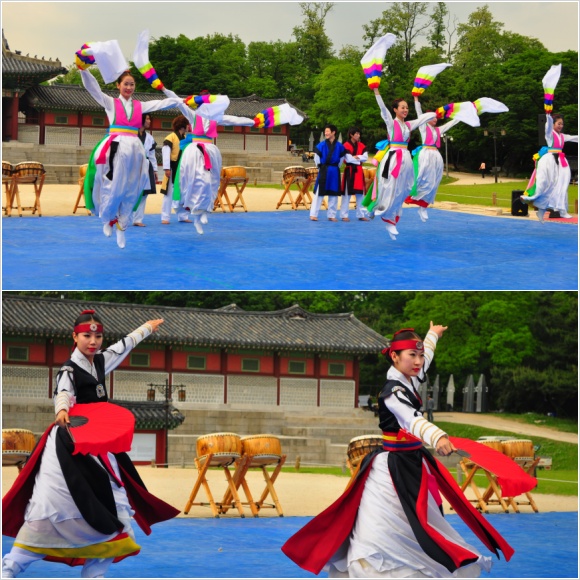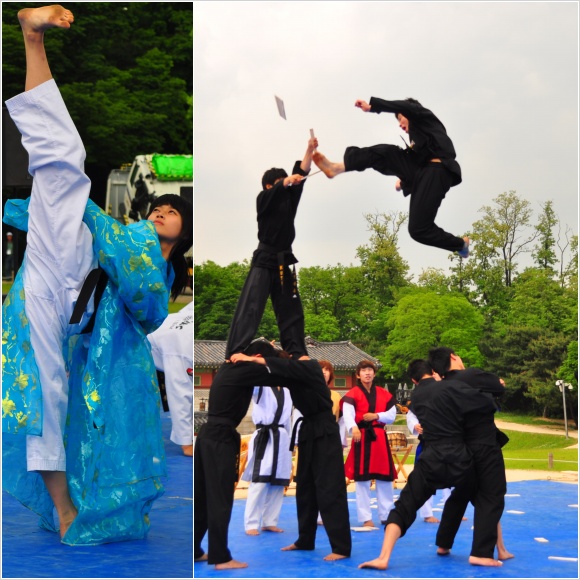Did you know Korea is the birthplace of taekwondo? Gold stars for you if you did. Despite having this nugget of knowledge buried in my brain I never actually went out in search of more insight about the martial art until I ran across a promo for a demonstration happening at Gyeonghuigung Palace.

Never one to pass up a free demonstration I immediately made plans to attend. The event is held every Wednesday and Saturday afternoon. The palace in question sits next to the Seoul Museum of History between Seodaemun and Gwanghwamun subway stations.
On the particular Saturday I decided to attend the weather was unseasonably hot for spring. The grounds resemble all of the other palaces you may have seen: ornate colorful woodwork in reds, blues, greens and yellows combined with intricately carved statues. I arrived early. I wanted a good spot. I didn’t know whether to expect huge crowds or a few spectators.
The demonstration area consists of a sea of bright blue mats that mirrored the sky overhead. Flaking the demo area sat two white tents billowing in the breeze. An army of plastic chairs set up before the mats waited eagerly for an audience. In the backdrop loomed the main hall of Gyeonghuigung Palace giving the scene a sense of majesty and purpose.
I took a seat in the front row, fidgeting with my camera to figure out the proper settings. It didn’t take long before more people drifted in. Husbands and wives pushing strollers, families herding their little ones, a group of giggling students, sun soaked tourists, and me waiting for the show to begin.
The crackle of a loudspeaker silenced the crowd. After a brief introduction in Korean, English, and Japanese the first performers took to the stage. A ragtag lot of tiny tots strode on stage. From their stone faces and high pitched shouts you immediately sensed there wouldn’t be any mugging for applause or attention. These kids meant business.
After the children performance the main event began. A cadre of female drummers in traditional garb took to the floor and began to pound out a thumping heavy beat. Dancers in flowing robes soon joined them, followed by the martial artists in an opening number than mixed dance and taekwondo in an effortless display. The cultural demonstration isn’t just a series of moves it’s a historical reenactment.
Check out the video at the bottom of the page.
1. Taekwondo Cultural Performance
Period: March 21 ~ December 2007
Time: 14:00~15:00, every Wednesday to Saturday
Venue: Gyeonghuigung Palace
2. Taekwondo Experience Program for Foreigners
Period: March 21 ~ December 2007
Time: 3 times a day, 6 days a week (except Monday), takes 90mins.
Venue: Gyeonghuigung Palace
In addition I learned they perform several different performances. So if you go back you may see something totally new.






Does this still happen every weekend?
I enjoyed your coverage on TKD but I am always saddened that most Koreans, even instructors know so little, if anything, about it's roots. Most TKD practiced in Korea is the WTF (World TKD Federation)which was introduced for the Seoul Olympics. However, this style has it's origins in ITF (International TKD Federation) which was the style developed by General Choi, the father of TKD and a patriot who for political reasons has been purged from Korean taekwondo.
I studied and taught ITF TKD for twenty years, having gained my first black belt as a solider in West Germany, where TKD first took a hold after various Korean delegations began promoting it abroad.
I have also studied WTF TKD up to red belt here in Korea. Styles always limit you and a good martial artist looks beyond them to perfect their technique and proficiency – whether that be combat, breaking, forms or simply fitness. However, it was ITF TKD that first spurred my interest in Korea at a time when little information about it existed. For example, ITF TKD has 24 forms, each inspired by some important cultural/historical aspect. Dan Gun, Won Hyo, the Hwa Rang Do, Gae Baek, Tong il, To San, Ahn Chang Ho, Yul Gok, Sam il, were all broght to my attention when studying the forms and before any grading one had to recite the background of each.
It is a pity that the contribution of General Choi should have been pushed aside and in effect hidden as ITF TKD and it's tenets and ideology encapsulate so much of the Korean spirit and the struggles of the Korean people.
I actually don't know what 'crime' Choi commited, and frankly it is immaterial. I belief he made some financial misdemeanor but his legacy deserves acknowledgment and I guess the point of this comment is merely to draw attention to this fact.
That aside, great article and photos. And I am of course, I am assuming the TKD demonstration is WTF because the uniforms in the top two photos are WTF style – yes, even the dobok differ!
Thanks for the commentary! I had no idea there was another more traditional form of Taekwondo in Korea. I wonder why they don’t incorporate it into their demonstrations?
One of my instructors in Korea used to be on the Kukkiwon Demo team. Hence, I've been to that palace three times for the demos–the demos were different each time, which was a nice surprise.
I didn't know there were different shows! Now I have another reason to go back!
About half the show (time-wise) was the same, the other half was different. Once they did a fan dance, the other time they did backflips hitting apples and causing apple bits to fly all over… that sort of thing.
If you’re not really “into” taekwondo, it’s probably not worth it to go again, but since I was studying taekwondo AND my instructor was on the team, it was worth it. Some good photo opps, too. Plus, I love that traditional farmers’ music.
(I went once with my parents when they were visiting, once on a field trip with my studio, and once when I was meeting some American taekwondo teachers who were training at the Kukkiwon for the summer.)